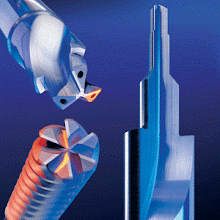
(mm/min) : Length of movement of cutting tool or workpiece per minute.
n (mind) : Spindle speed of workpiece (Turning)
Spindle speed of cutting tool (Milling. drilling)

fz(mmltooth) : Feed per tooth
z: Number of teeth
n (min-1) : Spindle speed

Feed Per Tooth : The distance traveled by a milling cutter divided by the number of teeth .(When milling)

Fz(mm/tooth) : Table feed
z : Number of teeth
n (min-1) : Spindle speed
Actual machining : Actual machining time represents the time spent on machining only. It does not include prep-time or the time needed for tool change .
Non-machining : Non-machining time refers to preparatory time and tool change time.
Continuous machining : Continuous machining is a condition in which the cutting edge remains in contacts a workpiece and continuously produces chips. (Mainly when turning and drilling, however due to workpiece geometry it may vary)
lnterrupted machining : Interrupted machining is n condition in which the cutting edge engages and disengages from the workpiece. thus there are areas where chips are not developed. (Mainly when rnilling.)
up cut milling (also known as conventional milling): A method of machining in which the cutting edge engages the work at a depth of Omm and then as rotating reaches the full depth of cut". When up cut milling is carried out the tool rotation is opposite to that of the direction of feed.

Down cut milling (also known as climb milling) : A method of machinine in which a cutting edge engages the workpiece at the full depth of cut and then aS rotating the depth of cut reaches 0mm. When down cut milling is carried out the tool rotation and the direction of feed is in the same direction.


0 comments:
Post a Comment